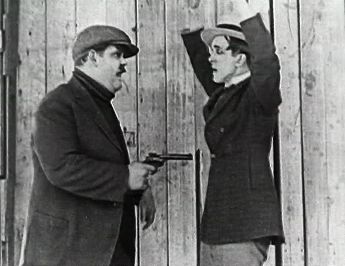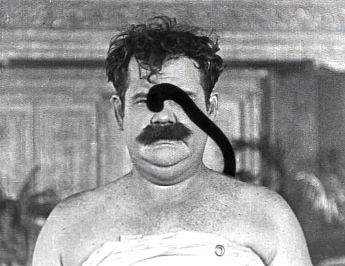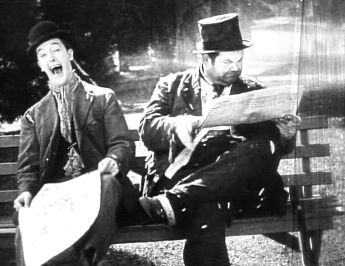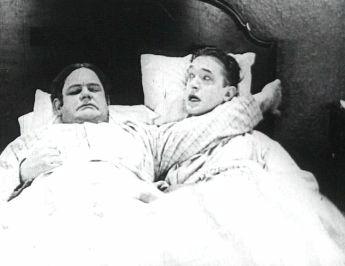(c. December 1920/January 1921, 24m) Director: Jess Robbins  No one's quite certain when The Lucky Dog was actually made. For years it was believed to have been made around 1917-1918 before a 1920 car number plate was spotted. To add to the confusion, it's not even clear whether the film was ever exhibited... what is known is that it was produced as a showcase for Stan's talents, and watched by, amongst others, Charlie Chaplin. The Lucky Dog is a fairly charming silent that sees Stan kicked out onto the street for not paying his rent and befriended by the dog of the title. Things get even worse when he stumbles upon a robber, played by Hardy, and get more complicated when they both end up in a manor house with a stick of dynamite. As both a piece of cinema and as a historical document The Lucky Dog compels and is worth seeing. For the two stars, however, it was just another job. For Oliver Hardy Vitagraph Pictures studios were the 14th studio he'd worked for, and The Lucky Dog was his 219th picture in a string of one reelers, two reelers, and features after six years in the business. After The Lucky Dog was complete, the two stars moved on, Hardy making another 59 pictures and only working again with Stan four years later, with Laurel in the capacity of writer and/or director on seven of his shorts. For Laurel it was a perfect arrangement. The Lucky Dog had been only his 15th film after just four years in the business, and Stan struggled to find his own identity on screen. Whereas Hardy had achieved success playing a string of character parts and 'heavies', Stan found his comedy best suited parodies of other movies, such as Dr. Pyckle and Mr. Pryde or Mud and Sand. In the mid 20s he made 24 shorts for Hal Roach before making a dozen more under Joe Rock, but his lack of consistent characterisation meant his career never really took off. In an interview with Bill Rabe in 1959 he made the observation about his comic persona on screen that 'I had no particular style, I was just fishing around, trying to find myself.' In 1925 Stan retired from acting to work behind the camera. Aged 36, he returned to the Hal Roach Studios as writer and director, noting himself in 1957 that: 'I wasn't too successful as a comic... they told me my eyes were too blue to photograph. That was a kind excuse, you know? One of those things. And I didn't feel I was so hot myself, so I was very happy to get into some other end of the business.' From that point on, Laurel and Hardy would be Hardy before the camera and Laurel behind it, with their onscreen performance together just a four-year memory.    (c. August 1926, 21m) Director: Fred Guiol Released: Path� Exchange, December 26, 1926  45 Minutes From Hollywood is an inventive farce that is episodic in nature. Beginning with a family travelling to visit movie studios, Rube Clifford's well drawn father role is written out about halfway through as the character falls off a train on the way to California. From then the film continues with his son, played by Glen Tryon, continuing the journey, along with a cameo from Roach's 'Our Gang' team. While Tryon's character and his wife get accidentally involved with a cross-dressing hotel robber, Ollie is on hand as the hotel detective. Wearing a bathrobe throughout the short, he is beaten up by his wife, terrorised by the bizarre sight of a cartoon cat and involved in a shoot out. In 1926 Stan was co-writing and co-directing a Harry Myers two reeler known as Get 'Em Young. With Hardy cast in the role of Summers, Myers's butler, filming was all ready to begin. Unfortunately a domestic accident had occurred at the Hardy household, with Ollie scalding his arm while cooking a leg of lamb. With no one else ready to play the role, Stan stepped in himself, briefly resurrecting his acting career and also inventing his trademark cry. Still reluctant to get in front of the camera, Stan would be involved with only the occasional bit part or small role for the next two years, and Roach drafted him into 45 Minutes From Hollywood for a small scene that lasted less than two minutes. Playing a sleeping hotel guest harassed by the various goings on in the hotel, Stan is hidden behind a large comic moustache and does the first cry witnessed in a Laurel and Hardy movie. Except, of course, this wasn't a Laurel and Hardy movie, but a Glen Tryon vehicle in which they both appear but never meet. Once more Stan, barring the odd extended cameo, would return behind the camera. And once more Ollie would continue to make shorts without him. But the day was getting nearer...    (September 1926, 20m) Director: Fred Guiol Released: Path� Exchange, March 13, 1927  By the time Duck Soup was made, Stan was now one of Hal Roach's 'All Star' players, along with Ollie, James Finlayson, Charlie Chase and Edna Marion. What's surprising is that their definite partnership here would then revert back to a series of cameos, bit parts, and coincidental co-appearances before, ten films later, it was realised that keeping them as a definite team would be a good idea. Recording an exact list of writers for Laurel and Hardy shorts is an impossible task, as the end results were the product of both collaboration and inspiration, often involving Stan and Hal Roach coming up with situations and H.M. 'Beanie' Walker devising the 'gag cards' explaining the plots. However, Duck Soup is slightly different as it was based heavily upon a theatre sketch written by Stan's father, Arthur Jefferson. First performed in Glasgow, October 1905, 'Home From The Honeymoon' saw two newlyweds seek a country house to let, only to be met by two burglars robbing the house. In order to get away the burglars pretend to own the property, running into trouble when the real house owner returns... Stan's integration in the 'All Stars' marked the beginning of a stability in his life. The day that Mae had returned to Australia Joe Rock had introduced Stan to Lois Neilson. The two quickly fell in love and were married on the 23rd of August 1926 shortly before filming on Duck Soup began.    (October 1926, 20m) Director: Fred L. Guiol Released: Path� Exchange, April 3, 1927  Of the 34 silents that Laurel and Hardy made, six of them went on to be remade as or significantly inspire sound shorts: Duck Soup as Another Fine Mess, Love 'Em And Weep as Chickens Come Home-, Hats Off as The Music Box, From Soup To Nuts as the opening section of A Chump At Oxford and Angora Love as Laughing Gravy and The Chimp. That's to say nothing of various routines lifted and refashioned for later effect. Slipping Wives, meanwhile, was remade in 1935 as The Fixer-Uppers. Rather than being a team in Slipping Wives, Stan and Ollie work against each other in this okayish short, Stan employed to make Priscilla Dean's husband jealous, and Ollie as her butler who takes an instant dislike to Stan. The short was actually a vehicle for Dean herself, a silent star who hit her peak in 1917. Speaking to Arthur Friedman in 1957 Stan recalled that 'We started to run out of star names [...] there were no more falling stars at that time. You see, at that time Priscilla Dean, Herb Rawlinson, they were kind of on their way out as you might say, so Roach took advantage of their name value, and put them into a two-reel comedy. People were aghast when they heard of Theda Bara in a two-reel comedy [...] so it was quite an attraction. But anyway, they ran out of stars, and finally we just kept making comedies with Laurel and Hardy in them, 'til finally Roach decided to make them Laurel and Hardy comedies.'   
| ||||||||||||||||||||||||||||||||||||||||||||||||||||||||||||||||||||||||